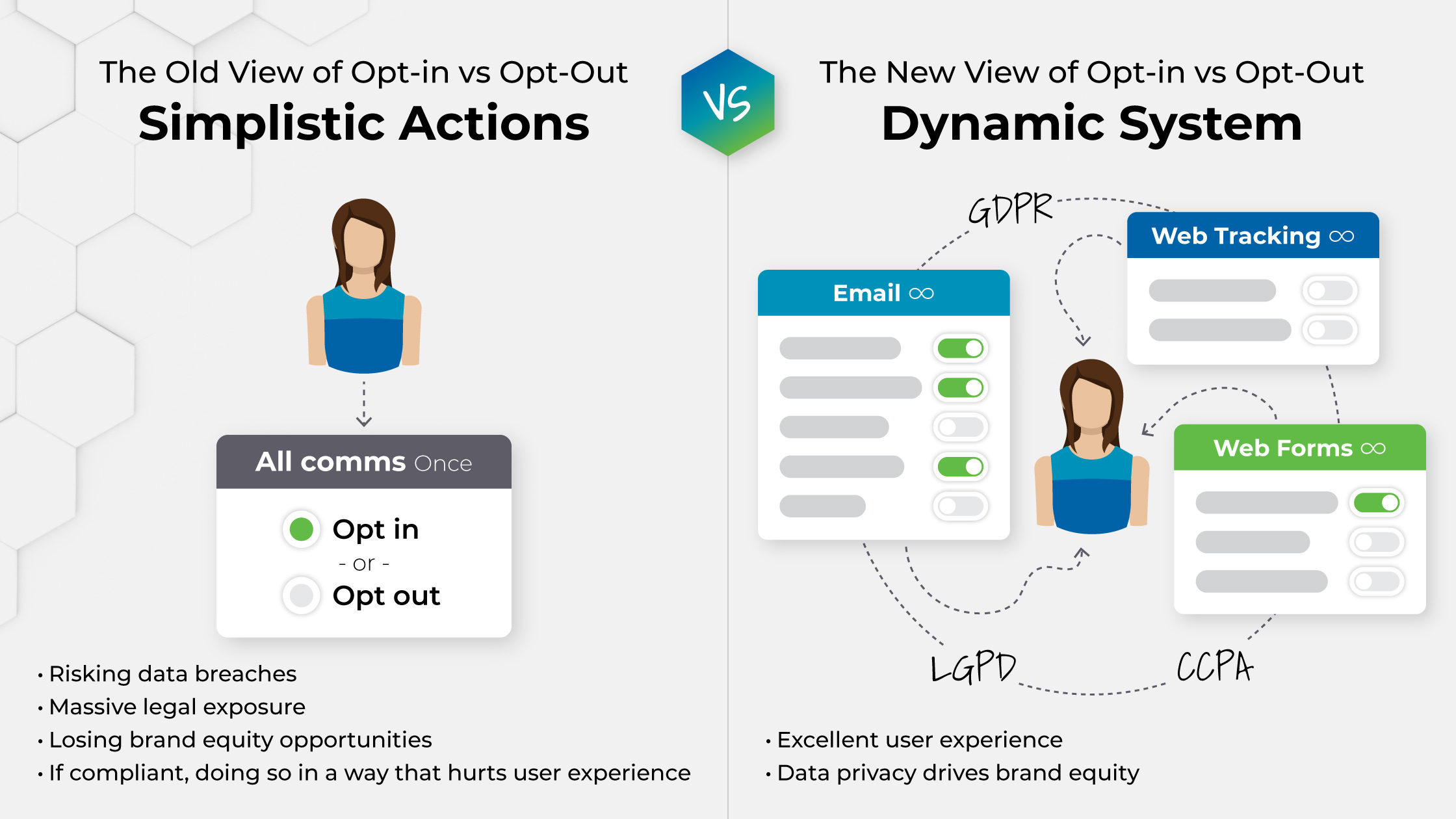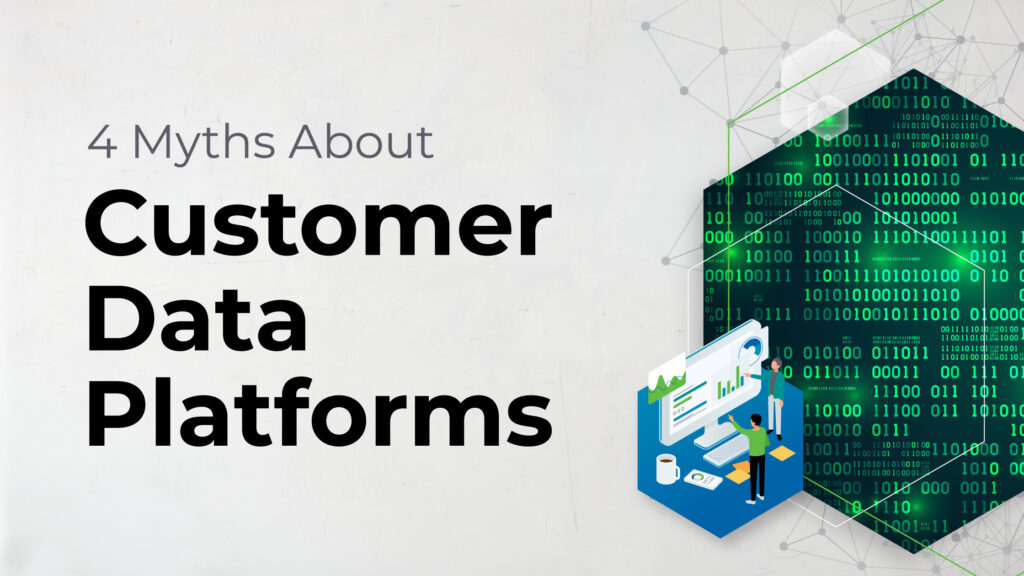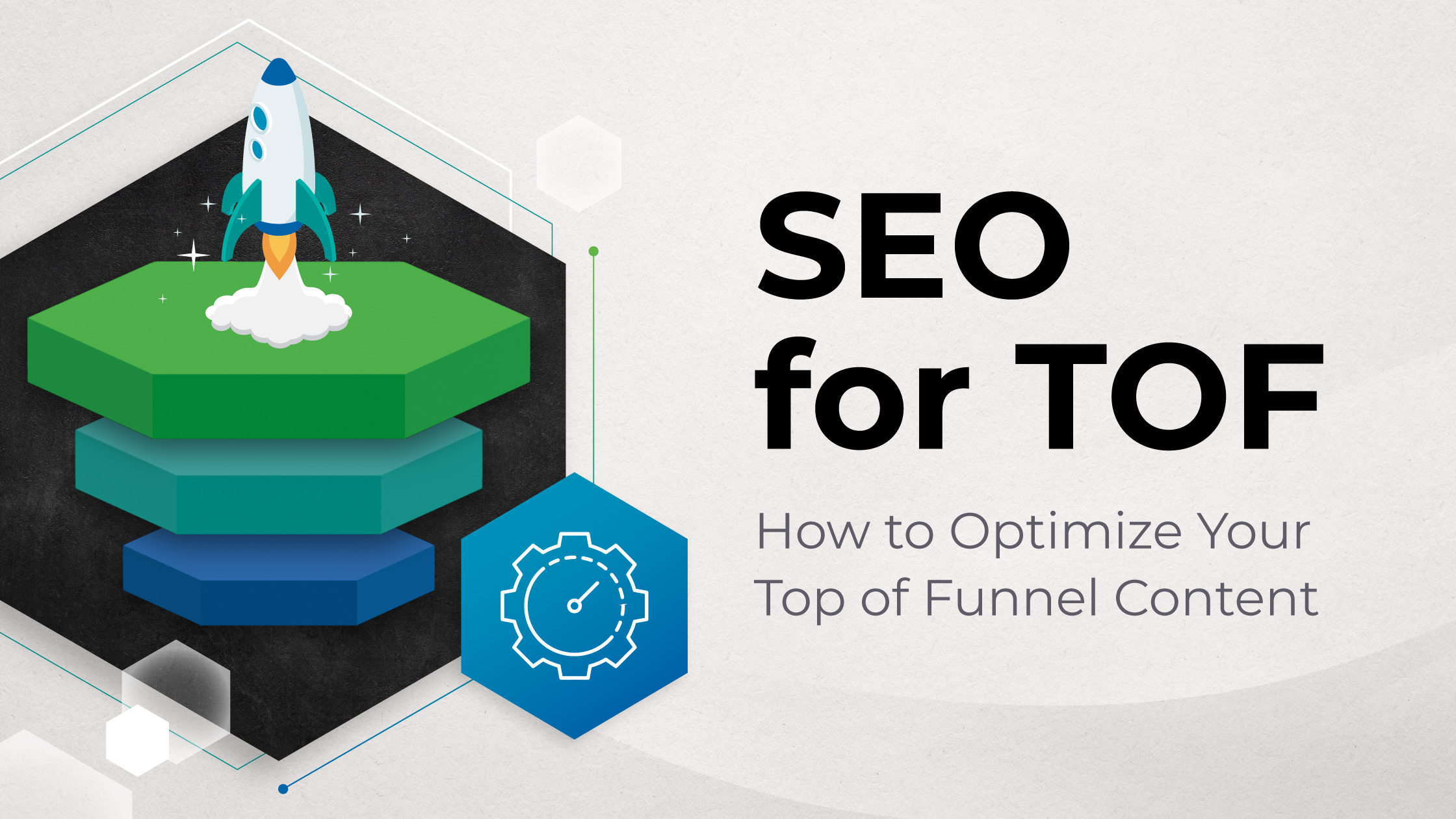
Diving into the world of data privacy can often feel like you’re trying to navigate a dense forest without a map.
With seemingly interchangeable terms like “Opt-in” and “Opt-out”, not to mention all the overlapping and changing privacy regulations, whyyy does it have to be so confusing??
Seeing you in exasperation hurts our heart, which is why our confusion-melting email marketing experts are stepping up to cut through the jargon and clarify the difference between “opting in” versus “opting out”, and why marketers need to evolve their understanding of these terms to ensure compliant, privacy-forward marketing success.
Here’s what we’ll cover:
- The basics of ‘opt-in’ and ‘opt-out’ (minus the headache!)
- The simple English version of privacy laws like CCPA , LGPD, and GDPR
- How to overcome the compliance challenges facing today’s brands
- How to navigate the privacy rules of email marketing with ease
Opt-in vs opt-out: Is there a difference?
The names might suggest the difference between the two terms is simply a matter of directionality – are people coming into or out of your email marketing ecosystem?
While that distinction is certainly a core difference between an opt-in vs opt-out, there’s a bit more going on here.
IMPORTANT: Don’t think about opt-in vs opt-out as simplistic actions. Instead, think about each as its own system of practices with distinct priorities to be managed.

What is opt-in?
Opting in is a proactive approach in data handling where users explicitly consent to share their personal information.
Opting in is grounded in the idea that user privacy is the default setting.
Users must actively choose to share their data, often by selecting checkboxes and/or submitting web forms on digital platforms.
Imagine you’re at a party and someone asks if you want to join their exclusive mailing list for future bashes. Saying “Yes, please!” is opting in. It’s like giving a high-five to share your details. Opting in is all about saying, “I trust you. Let’s do this!”
What is opt-out?
In contrast, opting out systems assume consent until the user explicitly withdraws it.
Opting out assumes that data collection is the default setting, and users are responsible for indicating the privacy level they desire.
It implies consent has already been given, and users must take steps to remove themselves from tracking and data-sharing activities.
Going back to our party invite list example… In this case, the party inviter assumes (based on a previous action or actions) your consent and you have to be the one to go the extra step and say, “No thanks. I’ll pass.”
In an opt-out system, brands assume you’re along for the ride…until you jump out of the car.
Data protection laws and regulations you need to know
We get it. “Data protection laws” doesn’t sound like a thrilling adventure for most of us. All the same, understanding and accommodating these regulations is now essential to brand success and longevity.
The big names you definitely need to know when it comes to data laws:
- GDPR – Europe
- CCPA – California/US
- LGPD – Brazil
While they’re all very similar – and differ mostly in specific implementations – each of these plays a vital role in protecting user data safety and ensuring the associated brand credibility that comes along.
Data Privacy, A Brand Equity Opportunity
Third-party cookies are being deactivated as we type this, and iOS updates continue to create ad performance challenges that. Learn how to position your brand to gain a competitive advantage by adopting a privacy-forward stance.
GDPR – Europe
The General Data Protection Regulation (GDPR) is a broad, comprehensive data privacy law in the European Union.
It emphasizes the opt-in approach, mandating explicit and informed consent from users before collecting or processing their data. GDPR opt-in requirements set a high standard for data protection, with strict guidelines and substantial penalties for non-compliance.
GDPR is like a strict but fair European parent who insists you ask permission before borrowing the car. It’s all about getting a clear “Yes” from people before taking their data for a spin.
CCPA – California/USA
The California Consumer Privacy Act (CCPA) is a state statute intended to enhance privacy rights and consumer protection for residents of California, USA.
And because most companies who do business in California also do business across the rest of the USA, CCPA has essentially become the country’s de facto privacy law.
It shares some core similarities with GDPR – providing protection guidelines for user data – but differs in the nuances of its opt-in and opt-out requirements, particularly regarding the sale of personal data.
The CCPA allows consumers to opt-out of having their data sold. It also gives consumers:
- The right to know what data is being collected and how it’s being used.
- The right to opt out of any data-selling practices.
- The right to delete personal data that’s already been collected.
- The right of non-discrimination in exercising these rights.
Notably, the CCPA requires opt-in consent to data selling when the user is under 16 years of age.
Where GDPR is a broad brush applying to any website or enterprise that collects data, the CCPA is only applicable if ONE of the following criteria is met:
- For-profit business with at least $25 million in annual revenue.
- Over 50,000 Californian users.
- Getting at least 50% of their revenue from selling data.
LGPD – Brazil
Brazil’s Lei Geral de Proteção de Dados (LGPD) mirrors the GDPR and CCPA principles, focusing on user privacy and data transparency.
Like the GDPR, the Brazilian law emphasizes clear opt-in methods while also providing guidance on data retention periods and compliance procedures.
The biggest difference is that the LGPD is even broader in scope than GDPR and CCPA, and its data retention guidelines apply to any and all data that could potentially be used to identify (either directly or indirectly) a user or their household.
And where the GDPR allows companies to use anonymous data without disclosure, the LGPD requires that any and all collected data be disclosed.
Our tips for navigating the challenges of data privacy compliance
Keeping up with ever-changing privacy laws while trying to give customers/clients a delightful customer journey is like playing a high-stakes game of Tetris. You’ve got to fit everything just right and level up your strategies constantly. And the evolving nature of these regulations requires continual adaptation and understanding.
Beyond that, implementation of any digital strategy often requires collaboration between legal, product, marketing, and development teams – which can be a collaborative nightmare for many brands.
The essential data protection goals for high-performing brands must be:
- Maintain compliance with all relevant regulations
- Provide users with a seamless privacy-first experience
- Establish a team infrastructure that can adapt quickly when changes in the law arise (as they keep doing)
How To Map Your Customer’s Journey
Explore our comprehensive guide on creating customer journey maps. Learn practical steps to understand and enhance your customer’s path. Be informed.
Most brands believe their data privacy practices are already compliant – and they’re wrong.
For years, data management and data privacy has either been grossly overlooked by most marketers, or teams have only briefly engaged with the subject in simplistic ways that have silently exposed their brand to enormous risk.
To better comply with GDPR and similar laws, businesses should:
- Regularly consult with legal experts to understand the nuances of all the various laws that apply to your brand. Plan regular, consistent meet ups with your legal team to decode any changes to the law.
- Invest in privacy-first technology. Make sure you’ve allocated resources for tracking and blocking technologies like cookie banners (OneTrust, CookiePro) and website code scripts.
- Establish an “always on” performance-monitoring culture.
- Some brands roll out a shiny new data toy and then become complacent based on the assumption that their privacy responsibilities are now sorted and they can set the topic aside for another year. (Red flag.)
- Other brands get stuck endlessly debating if and how to implement a change in their data privacy practices. As the internal discussions grind on, month after month, quarter after quarter, the brand is still grossly non-compliant. (Another red flag.)
Data management and privacy protocols must be continually monitored and optimized.
- Unlearn the myth that a one-and-done data privacy solution exists. (It doesn’t.)
- Challenge your team to stop procrastinating on making the tough decisions needed to ensure compliance and protect your brand.

4 Myths About Customer Data Platforms (CDPs)
Data-driven marketing without a Customer Data Platform (CDP) is impossible. Come learn what a CDP is, and why it’s essential for optimizing performance.
Email marketing and data compliance
Let’s shift gears to email marketing where keeping on the right side of opt-in laws is a non-negotiable.
The goal of any email marketing program is to build trust, strengthen brand credibility, and guide prospects along the customer journey, without stepping on any legal landmines.
2024 Email Regulations: Yahoo & Gmail Changes You Need to Know About
Discover how the 2024 email regulations may impact your business and learn about the new Yahoo and Gmail changes. Check out our email performance checklist.
CAN-SPAM Act – USA
The CAN-SPAM Act is a US-based law that determines the requirements for all commercial emails, and lays out recipients’ rights when interacting with those emails. Here are the main requirements:
- Ensure your email’s header, including the “From,” “To,” “Reply-To,” and routing information, correctly identifies the sender.
- The subject line must truthfully represent the email content.
- Clearly label your email as an advertisement.
- Include your valid, physical address in the email.
- Provide a clear and simple way for recipients to opt out of future emails, even if it’s part of a subscription service.
- Process opt-out requests within 10 business days without requiring additional information or fees.
- Be responsible for compliance with these rules, even if you’re outsourcing your email marketing efforts.
CASL – Canada
The Canadian CASL is basically identical to the CAN-SPAM Act in that it stresses overt consent and mandates both proper identification and an unsubscribe mechanism. Specifically, the requirements are:
- Accurately identify the sender and business in the email’s header information.
- The subject line must truthfully reflect the email’s content.
- Clearly disclose that the email is an advertisement.
- Include your valid, physical address in the email.
- Provide a straightforward method for opting out of future emails, regardless of subscriptions or memberships.
- Process opt-out requests within 10 business days.
- Take responsibility for email marketing compliance, even if outsourcing email marketing operations.
GDPR – Europe
For European email recipients, GDPR email marketing requirements contain the same explicit, unambiguous opt-in consent to data collection.
But since GDPR is more broad and mostly focuses on the processing/handling of user data, it doesn’t spell out a ton of specific requirements for emails.
In fact, even though GDPR is all about opting in, it considers email marketing to be a legitimate interest of the business and doesn’t require an explicit opt-in. The notable GDPR guidelines are:
- Email marketing and newsletters require consent or another legal basis to process personal data.
- Recipients can object to processing of their data for marketing at any time, overriding any business interest in marketing.
- Companies must inform data subjects about the basis of processing their data for marketing, whether it’s because of legitimate interest or explicit, opt-in consent.
Email opt-in best practices
Now that we’ve gone over the nitty-gritty of the legal requirements, let’s unpack some tips and tricks to make sure your email list grows with users you have a higher likelihood of converting and retaining.

- Make consent clear and conspicuous. Explicitly state what users are subscribing to and the type of content they can expect from you. Avoid being vague at every turn.
- Utilize “double opt-in” methods. Make use of confirmation emails to verify that the user has given consent and is interested in receiving emails.
- Keep unsubscribe options accessible. Make it easy to opt out within every email you send.
- Ask for renewed consent. Regularly reconfirm your subscribers’ consent to make sure that the users on your list are actively engaged.
- Segment & personalize. Tailor email content based on the details provided in each user’s initial consent.
Data privacy compliance doesn’t require abandoning the best possible user experience
Navigating the waters of data compliance and user privacy requires a harmonious blend of legal diligence and user-centric strategy.
If you’ve been told that you have to choose between user experience and complying with stringent data protection laws like GDPR, CCPA, and the like, you’ve been misinformed. Legal adherence IS possible while offering a seamless, engaging experience to your users.
Remember: The goal of these regulations and data practices is to foster trust and transparency, which is crucial for growing your bottom line.
Companies that engage in privacy-first marketing will protect their brand from legal action while building stronger and more meaningful relationships with their audience.
- Implement clear opt-in processes.
- Respect user preferences.
- Stay agile in the face of legal updates.
That’s literally it. You got this.
TL;DR on opt-in vs opt-out
- Opt-in prioritizes privacy as the default setting and requires explicit user consent for data sharing.
- Opt-out assumes user consent until users take action to withdraw that consent.
- Laws like GDPR, CCPA, and LGPD set strict rules for data privacy, offering consumers more control over their personal information.
- Email marketing compliance hinges on legitimate opt-in practices, accurate representation, and easy opt-out processes.
- Balancing compliance with a good user experience requires transparency, respecting user choices, and maintaining engagement through personalized content.







